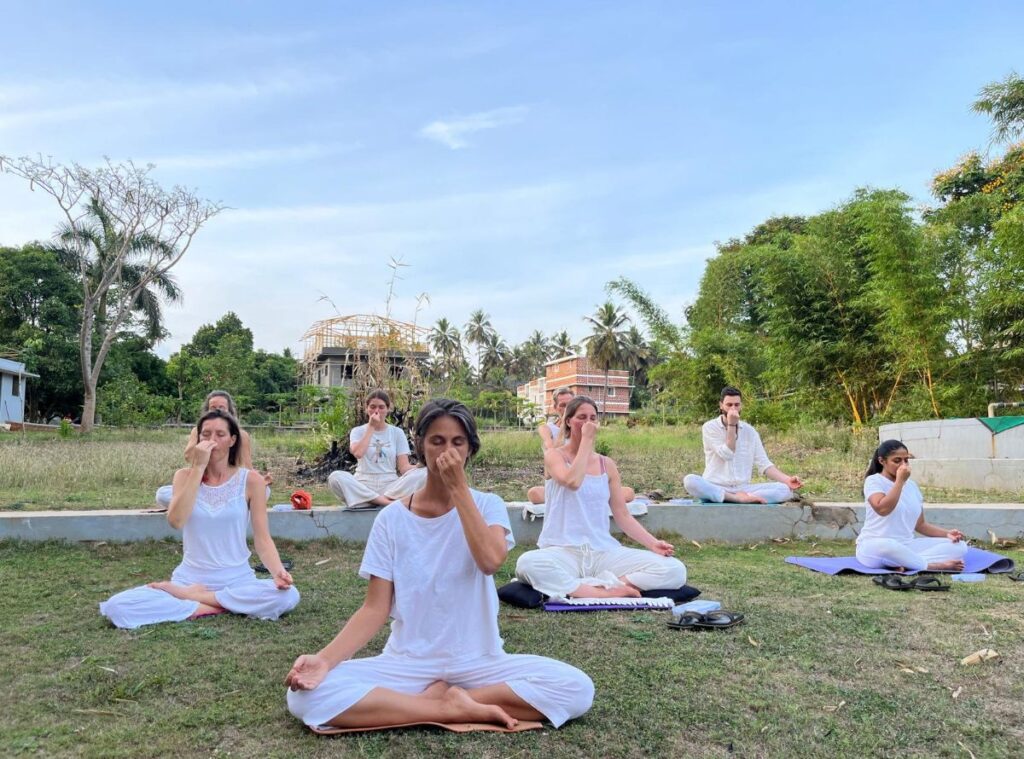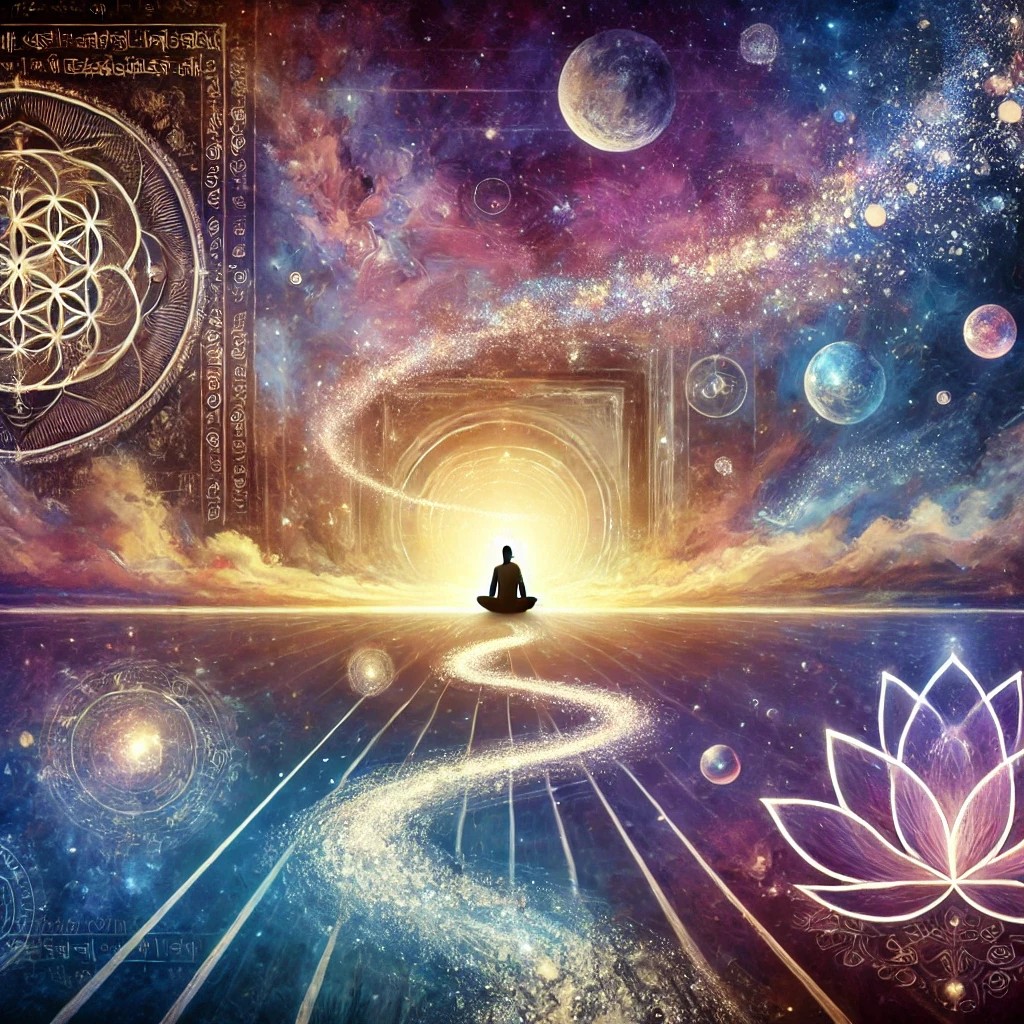By Remco, The Netherlands
Table of Contents
Introduction: the human search for depth
In today’s world of distractions and constant striving, living with meaning can feel out of reach. We may act endlessly, but are our actions connected to who we truly are?
Have you noticed how easily daily life drifts into doing without direction, like scrolling through social media for hours, rushing through tasks, or juggling obligations without pausing to reflect?
Sadhana deeply supports the search for meaning through the conscious decision to live a life of constant evolution. It’s the journey that takes you beyond the pursuit of external experiences and pleasure, helping you break free from the cycle of Karma.
In its essence, Sadhana provides the method to transcend limiting patterns, allowing you to align with the true purpose of realising your authentic Self.
Sadhana is the choice to move from the chaos of doing into the stillness of being.

Sadhana: the path beyond Karma
Sadhana is a dedicated, conscious effort to elevate yourself and expand your awareness. It is the path that breaks free from the cyclical nature of pleasure-seeking and external achievement.
Rather than chasing fleeting experiences, Sadhana offers a way to organise your inner and outer worlds. This practice is rooted in Yoga, where Yama and Niyama (the ethical precepts of Yoga) beautifully help to organise your experiences, creating space for simplicity and clarity.
Simplicity, from the perspective of experience, is the art of organising life so that unnecessary distractions and experiences no longer hold sway over you. In this organised space, the flow of energy becomes harmonious, allowing Sadhana to unfold naturally.
When life is simplified in this way, awareness begins to deepen. Instead of being pulled outward by every impulse, you start to experience a sense of centeredness and stability. This is where Sadhana transforms from being a practice into a way of being. It nurtures inner freedom, helping you relate to the world not from restlessness, but from clarity and presence.
Over time, this alignment allows your actions to flow naturally, rooted in purpose rather than compulsion.
Sadhana and the Yoga Sutras of Patanjali
Sadhana is deeply rooted in Patanjali’s Yoga Sutras, where it is described as a disciplined, conscious practice that purifies the mind and aligns one with the true Self. It is not merely external action, but a mindful inner effort, a journey of observation, regulation, and transformation. Through self-discipline (Tapas), self-study (Svadhyaya), and devotion (Ishvara Pranidhana), Sadhana gradually removes mental obstacles and cultivates clarity and freedom. Every thought, action, and breath becomes an opportunity to deepen awareness, guiding the practitioner toward the ultimate goal of Yoga: harmony of mind, body, and consciousness. Grounded in these Sutras, Sadhana is both a structured path and a lived, experiential journey toward inner liberation.
This inner alignment naturally leads to simplicity in practice. When the mind and actions are organised, each movement and thought can flow effortlessly, creating the space where Sadhana unfolds.

The role of simplicity in Sadhana
This natural flow becomes possible only when simplicity guides your practice, creating space for life to be lived with clarity. True simplicity is not about eliminating complexity, but about organising your experiences. By reducing distractions and unnecessary mental clutter, you create room for mindful living and deep practice.
In this organised space, Sadhana can unfold naturally. Each posture, each movement, becomes a natural expression of being. The challenge is to move from doing, which is a necessary part of life, to being, which requires conscious attention.
When doing and being merge, practice becomes effortless, and the flow of life aligns with the clarity and purpose nurtured through Sadhana.
The power of organised experience
In Sadhana, it is essential to first organise your experiences. Yoga offers a framework through Yama and Niyama that helps streamline your thoughts and actions. The more organised your inner world, the more fully you can experience life in its purest form, free from distraction and unnecessary complexity.
Simplicity is not about reducing the external world; it is about aligning your internal world so that each moment reflects your true purpose. This is also where self-reflection becomes important, helping you notice how doing, being, and simplicity play out in your own life.
Reflection Point 1
- How does the constant need to “do” affect your ability to simply “be”?
- Observe your patterns of seeking experiences or recognition by others.
- Where can you release unnecessary desires?
Reflection Point 2
- Where can you simplify your life to make room for Sadhana?
- Notice areas where complexity overshadows simplicity.
- Begin to organise your experiences more intentionally.
When you reflect in this way, simplicity shifts from being an abstract concept into a lived reality, preparing you for deeper practice.
Mastering the ability to experience
Sadhana is not only about external practice; it is also about cultivating a deeper awareness of your own inner world. By consciously observing and organising your experiences, you gradually move from reacting to responding, from being driven to being present.
- Awareness and Witnessing
- Humans have a unique capacity: the ability to witness their own experience.
- This awareness of perceiving, sensing, and interacting with the world is what sets us apart.
- The goal of Sadhana is not to suppress this ability, but to master it.
- Organising Experience
- As your practice deepens, you begin to see that not all experiences are necessary.
- You learn to organise experiences so they no longer control you.
- With this mastery, you are no longer driven by experiences or external impulses.
- Releasing Desire and Breaking Karma
- This release helps free you from the constant pull of external desires.
- When the need to experience falls away, you step outside the cycle of Karma; the endless repetition of action and reaction.
- Emergence of Clarity and Freedom
- The push and pull of external experiences that once consumed your time, energy, and attention lose their power.
- In this space, what remains is clarity, presence, and freedom.
Through this process, Sadhana transforms from a series of actions into a way of being. Mastery over experience allows you to live fully in each moment, guided not by impulses or external pressures, but by clarity, presence, and inner freedom.

The journey of transformation through Sadhana
When simplicity and flow are established, the real challenge of Sadhana emerges: overcoming the conditioning of the mind that shapes your actions. Conditioning extends beyond mental habits; it is shaped by life, societal norms, family, and past experiences.
Sadhana is about breaking these patterns and stepping into a new mode of being, where the need for external experiences gradually falls away. In letting go of the desire to experience, you begin to transcend the limitations imposed by conditioning.
In Yoga, the shift from doing to being is the path of freedom. This is where Sadhana offers true liberation. The essence of Sadhana is simply to be: moving from an experience-based life to a state of contentment that arises when seeking external experiences or validation no longer drives you.
As Patanjali explains: true contentment comes when you stop accumulating experiences and seeking approval. Only then can you access the peace that Sadhana nurtures.
The role of contentment in Sadhana
Contentment, as taught in Yoga philosophy, arises when the need to seek experiences fades. It marks a subtle shift, from looking for fulfillment outside to discovering it within.
When Patanjali speaks of contentment, he refers to a state of being in which you are no longer drawn into the endless cycle of seeking. True contentment is the ability to let go of the need to experience; it is the highest form of peace and liberation.
By releasing the constant pull of external experiences, you create a space to simply “be”. This is the culmination of Sadhana: moving away from endless striving and realising that everything you seek is already present within you.

Conclusion: embracing the shift from doing to being
The essence of Sadhana is not in doing more, but in being more. Through this practice, you gradually move from the chaos of external seeking to the simplicity and clarity of being. It is about organising your experiences, aligning with your true Self, and releasing the need for constant external validation.
Sadhana is a journey of gradual transformation, a process of discovering that true fulfillment arises not from striving or accumulation, but from the quiet, peaceful presence of simply being.
About the author

Remco de Groot has been exploring the many dimensions of Yoga and traditional Indian philosophy for over 30 years, gradually realising that Yoga practice and its philosophical foundation are inseparable. More than a discipline, Yoga is a way of living that dissolves the boundaries between oneself and Life, allowing authentic Self-expression to flow with ease.
In recent years, Remco has been living in Mysore, India, with his wife Martine and daughter Anna, as part of Yoga Gita’s global community dedicated to conscious living. Guided by Sage ViGo, their family volunteers together with other Yoga Gita sadhakas, supporting people in discovering holistic well-being through the integrated wisdom of Yoga.
To learn more about Yoga Gita Ashram, visit the website, or connect on Facebook, Instagram, and YouTube.





3 thoughts on “The Sadhana Journey: from Random Doing to Conscious Living”
THAnk you Remco, very Nice And clear!
I am glad you have enjoyed reading the blog!
Nice